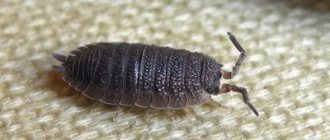What myrtles are grown at home?
There are species cultivated as indoor potted flowers. All of them are compact and suitable for forming a standard tree or a lush bush.
| Photo | Variety | Description |
| Common myrtle (Myrtus communis) | Decorative flowering plant of bushy form, evergreen. The leaves reach a size of 5 cm, leathery, oval, slightly pointed, dark green. The fragrant flowers are large, 2 cm in diameter. They have 5 petals. The berries are dark green or deep blue. | |
| Variegata myrtle (Myrtus Variegata) | Compact bush. The leaves are large, variegated, with a blurred light green edge and a sharp tip. Exudes a subtle and delicate aroma. It exists in a small-leaved variety, in which case some of the leaves grow white, and the bush seems to turn silver. In room conditions it grows up to 1 m. | |
| Small-leaved myrtle (Myrtus microphylla) | This is a variety of common myrtle. The bush is compact, the leaves are small, narrow, densely planted. Characterized by abundant flowering. The crown is dense. The plant reaches a height of 50 cm to 1 m. In a greenhouse it grows up to 2.5 m. If you knead the leaves, you can clearly smell the characteristic smell of myrtle. |
Types and varieties of myrtle with photos and names
Common myrtle (Myrtus communis)
This species is most often grown as an indoor plant. It has a small branching trunk. Its bark is covered with layered reddish-brown scales. The oval-lanceolate foliage is colored green. It has a glossy sheen and a leathery surface. The foliage exudes a pleasant scent.
The flowers of this species have prominent stamens and are white or light pink in color. Later, dark red berries form in their place. The flowering period lasts almost the entire summer. The Tarentina variety is popular. This is a more compact plant that produces more berries than the original variety. At the same time, their size is smaller. There is also a variegated form, the leaves of which have a light border along the edges.
Lush myrtle (Myrtus apiculata)
This species may appear as a tree or shrub with flaky brown bark. The trunk under the bark scales is painted in light colors. The foliage has a rich green color and a matte surface. Single flowers are painted white. They appear in the second half of summer. The dark berries that form in their place are considered edible.
Myrtus chequen
It is a tree with shiny green foliage. The edges of each plate are slightly wrinkled. This species is considered the most persistent of all.
Ralph's myrtle (Myrtus ralfii)
The species forms a bush with a straight trunk. It has pinkish flowers that turn into red berries. They can be eaten. There is a variegated form of this species. Its foliage has a cream border around the edges.
Myrtle tree: how to care for it at home
Caring for a plant is not only about creating optimal conditions. For the result, it is important to immediately decide what you want to get in the end. A neat myrtle tree with a scattering of fragrant flowers or a compact bush with a dense crown is formed in different ways.
Depending on this, different fertilizers are used. There are subtleties in pruning and pinching. In general, care is simple; you should not be afraid to plant a myrtle flower at home.
Where is it better to place: natural and artificial lighting
The sunniest place in the house should be given to myrtle. At noon, it is recommended to shade the plant from direct rays. If possible, take the pot outside in the summer; a balcony or loggia is also suitable.
In winter, for good development, you need to provide artificial illumination, so that in the end you get 12 hours. This is especially true if the pot is not on the windowsill, but in the back of the room.
In the autumn-winter period, direct sunlight is not scary for myrtle. You can safely place it on the windowsill. Whether the myrtle will bloom or not depends on the illumination. If there is not enough light, you may not see flowers at all.
Temperature
Right up to the frost, the myrtle can be on a glassed-in loggia. Then it is carried into the house and placed in the coolest place. In winter, at high temperatures (+23 °C... +25 °C), leaves begin to fall.
Myrtle prefers moderate air temperatures. In winter it should not fall below +6 °C (optimally from +8 to +10 °C); in summer the plant feels comfortable at +20 °C.
Air humidity
Particular attention is paid to the plant in winter. Dry air causes leaves to drop, they wither and turn yellow. Frequent spraying of the bush saves the situation. This applies to all varieties of indoor myrtle.
Place the pot in a pan of water, but make sure the drainage holes are not submerged in it. The task is to moisten not the soil, but the air. When wintering in optimal (cool) conditions, the bush is not sprayed.
How often to water myrtle in summer and winter
Myrtle loves moisture, so from spring to autumn, frequent irrigation of the soil is required, but without stagnation of water. In hot weather, water every other day, or even daily. In winter, the amount of moisture supplied to the roots is reduced to once every 2-4 weeks.
Overmoistening the earthen ball can lead to the death of the plant. It's better to underfill than overfill. Make sure that liquid does not stagnate in the pan, as this can lead to fungal diseases that are difficult to fight.
Soil for planting and replanting
It is better to give preference to neutral soil, since there is no consensus on whether to use slightly alkaline or slightly acidic soil. In this case, it is recommended to water the soil with slightly acidified water.
A store-bought mixture labeled “For flowering plants” is suitable. For reference, here is the composition: turf soil, coconut substrate, vermicompost, coal, sand. Be sure to put a layer of expanded clay on the bottom.
Feeding and fertilizers
From March to October, myrtle requires additional nutrition. During the period of active growth, it is recommended to feed it twice a month. With a break of 2 weeks, complex fertilizer and organic fertilizer are applied.
Universal Kemira is diluted according to the instructions. Horse manure is considered the most suitable organic material. The fermented slurry is diluted in a ratio of 1:15 and poured under the bush. For a good winter, start applying potash fertilizers from mid-August.
Landing
Planting myrtle
quite an easy procedure. It is best to use cuttings for this (a lot of troubles can arise with seeds).
The cutting will be able to take root very quickly if it is placed in a container of water. As soon as the first shoots begin to appear, you can start planting the flower.
Read also: Using soda at home
If you pluck the branches in the middle or end of the spring season, you significantly increase the likelihood that after planting the plant, the myrtle will grow lush and healthy.
Typically, plant growth can last from 3 to 5 years.
Location and lighting
After the myrtle has been planted, you need to think about where to place it in the house. The most suitable option may be window sills, which will be located from the west or east. If this is not possible, and you have to place the flower on the south side, then it is necessary to protect the plant from direct rays of the sun. Otherwise, the myrtle will not bloom, and its leaves will quickly fade.
It is believed that myrtle tolerates natural light well. But still, you need to be careful. If exposed to the sun for a long time, the plant may get sick and die. It is for this reason that in the summer it is necessary to worry about a suitable location for the flower in the house.
Pot size
When carrying out the replanting procedure, you need to worry about a new pot for myrtle in advance. If the plant has reached its maximum size or is still growing, then it is best to purchase a pot that is 2-3 times larger than the original one. You need to pay attention to tall and wide plastic pots, because quite often the root system of a flower grows greatly and begins to extend beyond the edges of the pot. With the right choice of this accessory, such trouble should not happen.
A pot that is too large is also dangerous. In this case, all the liquid will flow to the bottom, and the root system will absorb it. With prolonged exposure to moisture, the process of rotting may begin. Therefore, it is very important to monitor how often the flower is watered.
The soil
If you plan to grow myrtle in the house, then it would be best to prepare the soil, which will consist of turf soil, ordinary sand and humus. Before planting, all components are mixed together in a 1:1:1 ratio.
When purchasing land from a flower shop, preference should be given to soil for palm trees.
Transfer
After the winter cold has passed, the plant must be replanted. Before this procedure, it is necessary to purchase a convenient and correct size pot and prepare the soil, which will promote the active growth of the Mediterranean plant. The soil can be purchased at a specialized store, or you can prepare the soil yourself. Here everyone has the right to decide for themselves.
First of all, drainage is laid out at the bottom of the pot. For this you can use ordinary pebbles or coarse sand. The drainage layer is standard and is at least 3 centimeters. After this, a little soil is poured into the pot and the plant itself is placed. If the roots are not crowded, they do not bend and do not look out of the pot, then you can continue to cover the plant with soil. Do not sprinkle the myrtle trunk too heavily. It should always be level with the top of the pot.
After transplantation, the flower is watered or sprayed. This is done daily until the plant adapts to the new growth conditions.
An adult plant is replanted every 3-4 years.
Fertilizers and fertilizing
Fertilizers and top dressing for myrtle
necessary during the period of active flower growth from March to August. To do this, you can purchase the following fertilizers in the store: “Kemira-combi”, “Kemira-universal” or other types of fertilizers that are recommended for feeding house plants.
If the concentration of fertilizer is quite strong, then it can be diluted with plain water.
Proper watering
Myrtle is a very water-loving flower. Therefore, in no case should you allow the soil to dry out too much. If this happens, the roots will instantly react in a negative way, which can significantly affect the overall health of the plant.
It is best to water the world with boiled or settled water, which will not contain lime. Once every 7 days, the flower must be watered with water, to which a little lemon juice or citric acid is first added. If these components are not sufficient in the soil, then the plant's root system may not strengthen properly.
With the onset of hot weather, it is recommended to spray myrtle daily. The tray can also be placed in moistened expanded clay. But it is very important to ensure that the bottom of the pot does not come into contact with water!
Temperature
This flower is quite resistant to low temperatures. With proper care, it tolerates winter and late autumn well. So, during periods of severe cold, the optimal room temperature for a flower will be considered to be 7-10 degrees Celsius. The only thing you need to take care of is proper watering. Under no circumstances should the soil of the flower be allowed to become dry in winter.
If it is possible to take the plant to a balcony or loggia, then this can be done in the autumn. Only if the mark drops below 7 degrees, the plant will still have to be moved into the room.
If wintering is unsuccessful, myrtle may shed its leaves. But this is not a reason to get rid of the flower. Already in the first half of February, the plant will regain its strength and take on its previous appearance. True, flowering after this may not happen.
Humidity
The flower loves water and water procedures very much. Therefore, it is believed that it can be sprayed almost every day. The only exception is the winter period. At this time of year, watering should be avoided. The air humidity in the room where the myrtle is located should be at least 60%.
Trimming
Pruning this flower is the only way to change its appearance and shape. The most suitable period for this procedure is spring. If you pinch the branches in a timely manner, the plant will be very lush (pinching can be done at any time when the myrtle needs it).
Possible diseases and pests
If you do not monitor the level of air humidity in the room, myrtle can be affected by pests such as scale insects, spider mites and aphids.
- In the initial stages, scale insects are quite difficult to identify. But it will be able to infect most of the plant in a short period of time. At the same time, the leaves will begin to become covered with dark spots. To get rid of unwanted parasites, it is necessary to treat with a solution of soap and tobacco. In turn, you will also need to add kerosene and denatured alcohol to it. Adults are removed independently. To destroy young larvae, repeated treatment with the prepared mixture is carried out.
- When aphids attack, the leaves dry out very quickly. After all, the parasite is located on their lower part, and will continue to actively feed on plant juice. In order to destroy the parasite, you will need to use an insecticide. It can be purchased at a specialty store.
- Spider mites also attack the lower part of the leaf. At the same time, a small white cobweb appears on the flower. To protect the flower from death, it is necessary to thoroughly wash the leaves with water, and then treat them with a disinfectant.
- With little light, the leaves begin to lose their color and decrease in size.
- When the leaves turn yellow, it is necessary to limit the amount of natural light entering the plant.
- If the myrtle begins to shed its leaves, then this indicates a warm winter, or poor lighting in winter.
Read also: How to trim thuja at the dacha
Bloom
If you want to see how myrtle blooms, then you should not prune it in the spring. This procedure can be carried out only after the process of active flower blooming has ended.
When flowering, flowers grow on the top of the plant. With proper care and proper lighting, active flowering can continue from early June to late July. At this point, it is necessary to ventilate the room and ensure regular spraying of myrtle.
In order for myrtle to bloom every year, it must be fertilized. We mentioned how to do this correctly a little higher.
Plant propagation
By nature, myrtle can reproduce in several ways. These should include:
1. Reproduction using seeds.
This procedure must be carried out between March and April. The prepared seeds are scattered on the top of the ground and a little special substrate is poured on top. You will be able to notice the first shoots within 1-2 weeks. The plant sits in the prepared soil only when the first couple of leaves grow.
2. Reproduction by cuttings.
It is better to pre-harvest cuttings in May, August or November. Their length should reach 10 centimeters. The lower leaves must be cut off, and then the cuttings are sent for rooting. After 1-1.5 months, the young plant can be transplanted into a small pot.
Rest period
For myrtle, the dormant period begins in winter. That is why it is very important not to disturb the plant with the onset of cold weather. It is important to observe the temperature regime (7-10 degrees C), and reduce the amount of watering and spraying.
If there is an excess of moisture, the flower begins to shed its leaves.
In winter, it is also necessary to stop feeding the plant.
Beneficial properties of the plant and toxicity
From the very beginning of its existence, myrtle has been known for its unique and beneficial properties. If we consider it from a medical point of view, it can act as an analogue of antibiotics, since the plant contains bactericidal components. They, in turn, help heal and reduce the symptoms of diseases such as sore throat, flu, prostatitis, migraine and cystitis.
Myrtle can have a beneficial effect on the human immune system. It is recommended to be used as an additional treatment and for preventive purposes.
As for toxicity, there is no confirmation of this fact today. As you know, most myrtle fruits are edible and do not pose any threat to human and animal life.
So, if you are planning to start growing myrtle at home, then you need to know the following facts:
- The plant does not tolerate bright sunlight very well, but it does well with a little shade.
- If there is not enough light, the plant begins to die and shed its leaves.
- The flower is very water-loving, so regular spraying and watering is necessary.
- For an adult myrtle, you need to promptly change the top layer of soil, using mineral fertilizers.
The myrtle tree will be a great decoration for any home! For many years it will contribute to a calm and cozy atmosphere in the family!
Many flowers have a positive effect on human health and cleanse the energy of the home. Among thousands of beautiful and useful representatives of the flora, home myrtle is distinguished by a large number of beneficial qualities. This evergreen tree has been known to mankind for thousands of years.
Back in the days of Ancient Greece, people used myrtle in cooking, cosmetology and medicine. Spices were produced from it, myrtle oil was used for beautiful skin and hair, and medicines from this miracle tree were used for good health. Today, with modern technology and more knowledge, people have expanded the areas of its use.
If you want to have an evergreen myrtle at home, you will learn how to properly care for it in our article. In nature, the height of a myrtle tree can reach 5 m. At home, it grows to a maximum of 1 meter, but more often only up to 60-80 cm.
Trimming and pinching
The formation of a bush or tree is carried out if it does not matter whether the myrtle will bloom or not. Drastic pruning inhibits the formation of buds. Experienced flower growers recommend first forming a bush and then waiting for the flowers to appear.
Shoots are trimmed to 1/3 of their length. Pinching is most often practiced; it is performed on the third leaves.
To get a “ball”, the myrtle should not only be mercilessly plucked, but also the pot should be rotated around its axis (for uniform lighting). When growing myrtle from cuttings, immediately consider what shape you want to achieve.
If you prefer a tree with one trunk, pinch a branch at a height of 15-20 cm. It will begin to branch, the growing shoots can be shaped in any way you like - a ball, a crowned tree. Myrtle makes a magnificent bonsai.
Diseases and pests of myrtle, methods of combating them
To begin with, we note that myrtle does not have any special diseases or serious problems. But individual ailments can still sometimes occur.
For example, in poorly drained soil, a tree may develop root rot. Some problems may arise due to non-compliance with key care rules: insufficient lighting, poor watering. It is important to always take into account the fact that myrtle is a very fastidious plant, and therefore each condition for its care must be observed as precisely as possible.
Also, the tree is often attacked by insects: these can be thrips, scale insects, spider mites, and aphids. For this reason, you need to carefully monitor the condition of the plant and, if there are any negative signs, carefully inspect it for the presence of insects. This requirement is especially relevant in relation to old plants.
If pests are still found, then it is necessary to purchase the appropriate drug to combat them. This product must be used in strict accordance with the instructions.
Planting and propagation
Getting new myrtle is quite easy, unless you decide to do it with seeds, which germinate very poorly. If you still dare to experiment, keep in mind that the seeds need stratification.
Cuttings, on the contrary, take root well - both in the ground and in water. It is best to take a woody twig, but you can also take the top shoot obtained as a result of pruning (about 10 cm high).
Dip the cut in Kornevin, plant it in a cup with soil and place it in a greenhouse. It is done like this: cut off the top of a plastic bottle, place a glass with a handle in it, and cover it with a twisted lid.
Cuttings root well in a mixture of vermiculite, universal soil and sand, and peat tablets. In the latter, roots appear within a month, which are not injured when transplanted into a permanent pot.
Frequently Asked Questions on Growing Myrtle
Those who grow myrtle often have certain questions. We will look at the most common of them, and also try to give extremely detailed answers.
- Myrtle not growing?
The lack of tree growth can be associated with various factors. Here you need to, firstly, take into account that myrtle, in principle, does not grow too quickly. In addition, one should not expect active growth from it in the very first stages of development. For the rest, try to provide high-quality care and feed the plant well.
- Myrtle not blooming?
The tree will not bloom in several cases. So, if you pruned the plant in the spring, then you should forget about flowering this year. There will be no flowers even when the myrtle is kept in a poorly ventilated room.
- Are myrtle leaves withering?
In winter, myrtle may be left without leaves if its temperature is too high for a dormant period. A similar picture can be observed if the basic rules relating to watering the plant, spraying it and feeding it are not followed. Thus, the leaves of a tree can wilt when water stagnates in the tray. Or, on the contrary, it can happen if the soil dries out excessively between waterings. Among other things, the cause of leaf wilting can be excess sunlight. Therefore, when the first signs of myrtle wilting are detected, it is important to move it to a place protected from exposure to sunlight, adjust watering and start spraying more often.
- Is it poisonous?
Myrtle leaves are slightly poisonous. Long-term exposure to substances contained in the leaves can cause nausea and headaches in the most sensitive people.
Transfer
You should not replant myrtle immediately after radical pruning. Both are stressful for the plant. As soon as it moves away from the swift and begins to grow, it will be possible to replant.
A pot that is too spacious will not work. Usually the same one in which the myrtle grew is enough. You need to shake off the old soil or soak it in water. If you prefer compact plants, provide a tight container. Trim overgrown roots if necessary.
The soil is suitable for any commercial soil for decorative foliage plants. You can also use your own prepared from humus (1 part), garden soil (2 parts) and sand (1 part).
Transplanting myrtle
Myrtle is a slow-growing plant, and therefore it is not recommended to replant it too often. At the same time, all young trees should be replanted annually, increasing the volume of the pot. Adult plants can be in one pot for about 3-4 years. The most optimal time for replanting is winter, when the tree is dormant.
The entire transplant process looks like this:
- It is first recommended to dry the earthen ball, for which you do not water for several days. This will make it easier to remove the plant;
- Then you simply need to turn over the old pot with the plant and carefully pull out the tree, holding it by the base of the trunk;
- The roots of the plant need to be treated with some kind of stimulant, which will improve the survival rate of myrtle;
- The new pot is filled with expanded clay. We should not forget about drainage;
- Then the substrate is prepared. By the way, both during the initial planting and subsequently, the best substrate option is peat and turf soil (30% each), as well as humus and river or sifted sand (20% each);
- The finished substrate is poured onto the bottom of the pot;
- The plant is installed in a new pot, covered with substrate, leveled;
- After replanting, water the myrtle thoroughly until water seeps out of the drainage hole;
After all stages, the tree is transferred to a shaded place.
Why does myrtle shed its leaves?
When the heating is on and the air is dry, the myrtle begins to shed its leaves. In nature, it winters in open ground, where it is cool and quite damp. Try to bring the conditions closer to natural ones - place it where it is cool. Protect from the battery with a foam shield.
If the myrtle leaves a little in winter, this is normal. Even if the tree has completely lost its leaves, do not rush to throw it away. Wait until spring and water occasionally.
In most cases, the plant awakens and new leaves appear on it. If this does not happen, unfortunately, we have to admit that the flower is dead.
Myrtle blossom
Those who want to get myrtle flowers should know that to do this they should not prune the plant in the spring. In general, it is better to postpone pruning until flowering has ended.
The flowering period is the beginning and middle of summer, June-July. In order for the flowers to turn out beautiful, two rules must be followed:
- Provide proper care for the tree;
- Provide constant access to fresh air for the plant.
Inadequate care will lead to the development of diseases, and in this case there will be no need to talk about flowering. Flowering is also not observed when myrtle is kept indoors, where the air is predominantly stagnant.
The flowers themselves on the tree in question are arranged like this:
- Or singly in leaf axils;
- Or being collected in brushes.
There are usually 4-6 petals, but the flowers themselves are simple and double. The main part of the flowers is located in the upper part of the plant, since that is where the best illumination is.
Myrtle flower - home care
It is important to know how to care for myrtle so that it pleases with its flowering and does not react to bad conditions by dropping its leaves. He loves climates with high humidity, but is not afraid of drafts. When caring for exotic myrtle at home, it is necessary to ensure that some important maintenance conditions are met. Among them are maintaining the desired temperature level and correct placement:
- The bush loves diffused bright light and plenty of fresh air.
- In summer, it is recommended to keep the flower at a temperature of +22-24°C, take the container to the balcony and ventilate it. In winter, the temperature is allowed to be reduced - at + 15-18 ° C the plant successfully overwinters.
- It is recommended to place myrtle on southern windowsills, shading it from direct sunlight - there it will bloom more profusely.
How to water myrtle?
When caring for myrtle, it is important to provide it with regular watering, because the plant comes from the tropics and prefers high humidity. In addition, the flower needs regular spraying. Moisten and irrigate the bush with soft, settled water. When asked how often to water myrtle, experienced gardeners advise doing it twice a week generously in the summer, and reducing watering to once in the winter.
In this case, you don’t have to wait for the top layer of soil in the vessel to dry out; the main thing is to drain the excess water from the pan half an hour after the procedure. The soil should not be allowed to dry out too much, otherwise the plant will begin to lose leaves and may die - there should always be moist soil in the pot. When cleaning, it is very important to ensure that the water in the vessel does not stagnate.
Pruning myrtle
If myrtle grows in your home, caring for it at home involves pruning. They make it possible to radically transform the outline of a plant; it is better to carry them out in the spring no more often than once every 2 years. You can pinch young branches all year round - this way you can increase the density of the bush. But with frequent pinching, the crop begins to bloom less, this must also be taken into account. Myrtle tolerates pruning well; you can shape its crown at your discretion. The main condition is not to expose the trunk too much. Myrtle - possible pruning and crown formation:
- If myrtle is not pruned, it will eventually take on a pyramidal shape.
- If you trim the top of the tree, you will end up with a squat, thick cushion.
- If you cut off the sides of a bush, it will acquire a high crown on the trunk.
Transplanting myrtle after purchase
A couple of weeks after the tree appears in the house, it is better to replant it. It is better to do this from January to early November - this period is the most painless for myrtle. When replanting, it is better to treat the roots of the tree with some kind of biostimulator of growth - this will improve their survival rate. First, it is better to move the bush into a pot of the same diameter in which it was purchased, filled with fertile substrate. This will make it easier for the plant to fill the fresh soil with the root ball. After relocation, the flower must be watered well until water flows out of the drainage holes.
How to care for myrtle in a pot
The myrtle tree, which is cared for at home, is distinguished by the fact that the plant must be maintained differently in winter and summer, and requires special attention. Lighting, soil moisture, and temperature, depending on the time of year, have characteristics for this home flower.
Lighting
Indoor myrtle is photophilous. Ideally, you should provide the tree with a 12-hour day. This is easy to do in the summer. If you live in a private house, dig myrtle in your garden in the warm season, and if in an apartment, take the pot with the tree to the loggia or balcony. Thus, in addition to good lighting, which the flower so needs, it will also be in the fresh air.
In such good conditions, myrtle will grow faster and will delight you with a lush crown. If it is not possible to take the flower to the balcony or plant it outside, simply place the pot on the windowsill in the part of the apartment where there is more light.
In winter, myrtle remains dormant. How long the plant will remain in it depends on the amount of sunlight.
If there is a lack of lighting in the cold season, it is recommended to use phytolamps. Even if the light is not too bright, it will be enough to maintain the normal functioning of the flower.
Tip : Do not place myrtle on the north side of the room. Due to lack of light, growth will stop and it will lose leaves.
Watering
How to water myrtle depends on the time of year. The soil should not dry out more than 1 cm. Therefore, in spring and summer, provide moisture up to 4-5 times a week. If stagnant water has formed in the pot, drain it and leave the flower until the soil begins to dry.
If indoor myrtle begins to wither from lack of liquid, immerse the flower pot in a basin or bucket of water for 15 minutes. Strain the remaining liquid and continue watering as before.
In winter, there is no need for frequent moisturizing; 1-2 times a week will be enough. The lower the temperature, the less the flower needs liquid. Water the tree only with settled, or even better, melted or filtered water.
What should the humidity be?
The myrtle flower is moisture-loving. For good growth in apartments where the air is dry, its humidity should be increased. In spring and summer, when it is very hot, spray the flower with water at room temperature from a spray bottle or take a warm shower.
To do this, carefully wrap the pot with the tree in film and place it under the watering can. In winter, myrtle does not need spraying; moderate watering will be enough.
Optimal temperature
In the warm season, for a tree, the range from 20 to 27 degrees Celsius is sufficient for the high-quality development of myrtle and its further flowering. In winter, when the domestic tree is dormant, the optimal temperature is from 10 to 15 °C.
Read also: How to make a drilling machine with your own hands drawings
Don’t be afraid to display a flower on a glassed-in loggia. In winter, it is better to bring myrtle indoors. At temperatures below 5°C, even if the plant does not die, this will affect its awakening in the spring. It will be later, and flowering may not occur at all.
If the temperature is too warm in winter, the tree can lose leaves, but will still recover in the spring, although it is unlikely to bloom.
What kind of soil does he like?
A specialized store will tell you what kind of soil is needed for myrtle. It grows in any well-drained soil. For the tree, soil suitable for citrus and palm trees is suitable. And if you wish, you can create the optimal mixture for the flower yourself.
For this you will need leaf, peat, turf soil, sand and humus. Myrtle will also benefit from charcoal, which would be a good idea to add to the resulting soil mixture.
If it is not possible to get all types of soil, myrtle will grow in simpler soil, consisting of turf soil, sand and humus. Mix all these components in equal parts.
Tip : take care of drainage for the plant. It will promote proper circulation of air and water in the soil.
How to fertilize
To maintain good flower health, you need to know what to feed myrtle. Fertilizer is produced only in the warm season, during the period of tree growth and flowering. Don't overdo it by continuing to fertilize during the winter, or your myrtle will lose its leaves. From spring to autumn, use fertilizers once a week.
Choose mineral and phosphorus when you want your myrtle to bloom more, as well as nitrogen if you want to get a beautiful little tree. Complex fertilizers such as Kemira universal are suitable for the general maintenance of high-quality life activity of myrtle.
How to control pests
The appearance of insects must be taken seriously and special attention must be paid to the maintenance of both the diseased flower and those located near it. The most common pests among all indoor plants are spider mites, scale insects and aphids. They do not ignore home myrtle.
Scale insect or aphid
When a tree is infected with scale insects, brown spots form on it, the leaves droop and subsequently fall off. Remove pests using a sponge soaked in soapy water, and treat the entire tree with an insecticide.
You will find aphids on the bottom of the leaves. It is dangerous because it sucks the juice out of them, as a result of which they begin to dry out. You can get rid of an aphid infestation using the same insecticidal agents. First you need to remove small insects under a stream of water, holding the myrtle with the crown down.
Spider mite
Spider mites, like aphids, are located on the lower part of the leaves and envelop them with thin threads. Not all insecticides will help get rid of mites. Acaricides such as Actellica and Sunmite will come to the rescue.
Myrtle - propagation at home
Bush myrtle propagates in two ways - seeds and cuttings. The second method is simpler and more reliable - this way you can preserve all the maternal and varietal traits of the plant. When propagated by cuttings, the myrtle flower will bloom faster; with the seed method, the first buds will appear on it only after 5 years. Therefore, if you want to quickly grow an exotic tree at home, it is better to ask your friends for a cutting after pruning.
Myrtle from seeds at home
Seeds are sown in spring. This method of reproduction is less effective, but it is also used. How to grow myrtle from seeds:
- The prepared substrate (one part peat and one part sand) is poured into boxes 8-10 cm high.
- The seeds are placed evenly over the soil surface and sprinkled with 3-4 cm of soil on top.
- The crops are moistened and covered with glass to create greenhouse conditions.
- For seed germination, a temperature regime of around +20°C is required.
- Periodically, the glass must be opened to ventilate and remove condensation.
- The soil must be kept moist.
- The first shoots will appear after a couple of weeks, when there are too many of them, you can thin out the shoots.
- After 3 leaves appear on the seedlings, they are transplanted into separate pots with the same substrate.
- A month later, young plants are fed with a low concentration of nitrogen.
Myrtle - propagation by cuttings
The best results are obtained from semi-lignified cuttings of the current year; they should be cut in January-February or mid-summer (July). The shoots should be taken from the lower or middle part of the tree, their length should be 8-10 cm. How to root myrtle with cuttings:
- You need to remove the lower leaves from the shoot and shorten the upper ones by a third.
- The cut should be treated with Kornevin or Heteroauxin.
- For rooting, a mixture of leaf soil (1 part) and coarse sand (0.5 parts) is suitable.
- It is better to take a wide and low container for rooting.
- The cutting is stuck into the prepared soil and covered with a glass jar.
- Rooting occurs at a temperature of +17-+20°C, the shoots do not need light - on the contrary, they need to be shaded.
- Periodically the jar is removed for ventilation.
- The roots grow within a month, the cutting is transplanted into a pot with a diameter of 7 cm with the same soil mixture.
- A year later, it is transferred to a container measuring 9 cm in soil for an adult myrtle, and further care is provided, as for an adult plant.
- When propagated by cuttings, the bush blooms in 3-4 years.
Growing myrtle from seeds
How to propagate myrtle by seeds at home? At the beginning of spring, myrtle seeds are sown on the surface of a substrate consisting of equal parts of sand and peat, in a container 7-10 cm deep, sprinkled on top with a layer of the same substrate 3-5 mm thick and, covered with glass, kept at a temperature of about 20 ºC, ventilating and moistening the crops, as well as removing condensation from the glass.
- How to care for ficus
Shoots appear in a week or two, and when the seedlings grow 2-3 true leaves, they are planted in the same substrate in individual pots so that the root collar remains above the soil surface. A month after picking, the seedlings are fed with nitrogen fertilizer of weak consistency.
However, amateur breeders should know that myrtle grown from seeds:
- will bloom no earlier than in 4-5 years;
- is unlikely to retain varietal characteristics.
In addition, the germination of myrtle seeds sharply decreases after just a year of storage, and obtaining them is problematic, since this will require artificial pollination of the plant.
myrtle tree
The myrtle tree is native to the Mediterranean. In nature it reaches 3-5 meters in height. At home, this tree is from 50 cm to 1 meter. Myrtle is an amazing plant, it is fragrant, blooms with white flowers, and the fruits are dark green berries.
Translated from ancient Greek, the word myrtle means balm or myrrh. Since the times of Ancient Greece and Rome, myrtle has remained a symbol of beauty and youth. It is valued not only for its decorative effect, but also for its antibacterial properties. The scent of myrtle will reduce the number of germs by at least 80%.
An infusion of myrtle leaves is good for refreshing the skin, and wine infused with berries is a real elixir. Myrtle is very favorable for the climate in a children's room. But myrtle will require constant attention, good care, and love.
The myrtle tree responds well to pruning, loves well-lit sunny places, fresh air, and will feel great in the summer on the balcony and in the garden.
Pay attention to the inadmissibility of drying out the soil in pots. Excess water is also harmful to the plant. The myrtle tree, native to the subtropics, will require a humid climate, so it is good to spray the leaves with warm water from time to time.
Myrtle - plant features
Myrtle is native to the Mediterranean, but it also grows in North Africa (in Europe it freezes after the first frost). Depending on the variety, the heat-loving plant in the form of an evergreen shrub in these parts reaches a height of 3.5 m, due to which it is grown as a garden crop in tubs or in open ground. The bush is even pruned to give the crown the desired shape.
The leaves contain an aromatic substance: its smell is clearly audible if you rub or cut it in the place where the veins are located. The Latin myrtus “myrtle, a southern evergreen plant containing essential oil in its leaves” comes from the Greek μυρρα “myrrh, liquid incense.”
A striking representative of the family is the common myrtle. It is a shrub up to 2 m high with dark green leathery leaves and small white or pink fragrant flowers. The fruits are edible black berries on which the calyx of the flower is attached.
After flowering, dark round or elliptical fruits with seeds are formed on myrtle.
There are many varieties of plants in the myrtle family. Interestingly, eucalyptus is also included in it. However, only a few varieties are suitable for home use. Caring for them is simple, but they need to create acceptable conditions, for example, high air humidity, ventilation and regular watering.
Indoor varieties
Despite the modest variety of suitable varieties, the choice of myrtle for the home is nevertheless even more limited due to supply. The optimal solution is not to purchase it in stores, but to grow cuttings from plants that have taken root with friends. If you have a choice, it is better to pay attention to the varieties described below. They differ in the shape and size of leaves, flowers, fruits, and are also considered the most unpretentious and compact varieties:
- Alhambra - dense, leathery leaves, white fruits and flowers.
- Microphylla is a dwarf tree with small leaves.
- Flora Pleno - distinguished by fluffy, double flowers.
- Tarentina is a fast-growing tree with small leaves and abundant flowering (for example, Tarentina Granada, Tarentina Variegada, etc.).
- Boetica is a slow-growing tree, its trunk curls over time and is a rich shade of cinnamon.
It is noteworthy that all of the listed varieties belong to the common myrtle species.
Photo gallery: domestic species of myrtle
Myrtle Alhambra is distinguished by its abundant flowering and fragrant fruits.
The easiest variety to find on sale is Microphylla.
Double flowers are perhaps the only thing that distinguishes Flora Pleno from other varieties
Myrtle Tarentina Variegada is decorated with elegant leaves with a white edge
Myrtle boethica has large leaves, larger than other species (6–7 cm, while the standard is 1–2 cm), with a pointed end
According to experts, any variety of common myrtle is suitable for bonsai.
Myrtle lends itself well to shaping, making it relatively easy to grow in bonsai style.
But the most original trees will come from the Boethica variety and the dwarf Microphylla: their crown and trunk are easy to form due to the slow growth and pliability of the shoots.
Myrtle - home care in winter
In winter, indoor myrtle needs peace. To do this, water it less and place it in a cooler place with a temperature of up to 10 degrees.
In winter, it is better not to spray the plant, otherwise the myrtle may shed its foliage. Leaf shedding can also occur at elevated room temperatures. In spring, the myrtle will turn green again as before.
Fertilizing in winter is not recommended.
Myrtle is also interesting because its crown can be decoratively shaped into a ball, cylinder or any other shape. The only downside will be a reduction in its flowering period.
Useful properties of myrtle
The phytoncidal effect of myrtle is so great that it can destroy not only ordinary bacteria or microbes, but even tubercle bacilli, staphylococcus and streptococcus. The plant can also be a good helper in the treatment of colds. But using homemade myrtle for medicinal purposes, freely consuming its foliage, can be dangerous to health.
Decorative foliage plants Indoor plants
How to propagate myrtle at home
Myrtle easily propagates in both spring and summer. Propagation methods such as seeds and cuttings are suitable for this. For planting, take non-lignified cuttings measuring from 6 to 10 cm and plant them in soil made from a mixture of peat and sand to a depth of 2 cm.
In order for the cuttings to take root well, they are placed in a bright place at room temperature of about + 20 degrees. It is necessary to make a micro-greenhouse and cover it with a jar to maintain soil moisture. Roots will begin to develop after two to three weeks. Ventilation is required.
Myrtle propagation
There are two ways to propagate myrtle:
- Cuttings;
- Seeds.
Propagation by cuttings will occur if the soil temperature reaches 25 degrees. This is an extremely important condition.
Propagation is carried out using apical cuttings.
- A cutting that has reached a length of 7-9 cm must be cut from a side shoot. You can also use a shorter cutting (5-7 cm), but in this case it is necessary to cut it from the main, but not flowering, shoot. The lower leaves must be removed, and the formed cut must be processed using Kornevin.
- The next step is planting cuttings.
A mixture of sand and peat is ideal for this purpose. The cuttings are placed in this mixture and covered with a loose film on top. The rooting process occurs at room temperature. The result appears after approximately 2-3 weeks. After the allotted time has passed, the cuttings can be planted in separate containers.
Another propagation option is using seeds. This method has a significant drawback: the seeds take a long time to germinate. But many are already familiar with such difficulties and may try to grow myrtle this way. To propagate by seeds, you need to prepare a substrate consisting of peat and sand. It is also recommended to sprinkle the mixture with a little soil. The substrate and soil on top are covered with plastic film.
For successful germination, it is important to meet two conditions:
- Provide diffused light;
- Monitor the temperature, which should be maintained at 21 degrees.
It is equally important to form a crown with this method of reproduction:
You need to pinch the sprout at a certain height. Flowering of young plants should be expected in the second or third year.
The myrtle tree is a symbol of peace and tranquility in your home
For lovers of light and natural aromas, myrtle is best suited: it helps improve indoor air, improve the atmosphere, and its leaves are used as a medicine. In addition, it is grown to create a bonsai style tree. And among the variety of varieties, you can choose ones that are suitable for both beginners and experienced gardeners: care is not difficult, but you should still remember some features.
Short description
In the wild, the myrtle tree grows in the Mediterranean and is found in Italy, France, and Spain. It prefers a warm, mild climate with short winters, so in Russia it is most often cultivated as a houseplant.
Myrtle tree is a great option for growing at home
A representative of the Myrtaceae family can be a shrub or a low tree. The height of the trunk is up to 0.7 meters, but in the natural environment it grows up to 5 meters.
Features of myrtle:
- Evergreen species.
- The leaves are rich green, with tiny veins. Rich in essential oils, therefore they emit a stunning aroma.
- The flowers are small and white. Collected in inflorescences or solitary.
- The round fruits of myrtle are a deep blue hue. The seeds inside can be used for propagation.
Note! At home, you can grow myrtle as a bonsai, but you will have to do regular pruning.
You can grow myrtle at home on the windowsill; this does not require specific knowledge.
Popular varieties and types
There are more than 30 varieties of myrtle in nature, many of them have good decorative properties and are grown in greenhouses and greenhouses. But some are suitable for a flower garden in the house.
The simplest is considered to be the common myrtle, attractive, but undemanding to care. You can also plant the following varieties in your apartment:
- Cassandra (marsh variety of myrtle), height up to a meter. Suitable for responsible gardeners without children or pets, as it is poisonous.
- Hymen. Considered the patron saint of newlyweds.
- Communis. Decorative variety with snow-white fragrant flowers.
- Variegated. A beautiful elegant plant with brightly colored leaves.
- Citric. It has a subtle unobtrusive citrus aroma.
- Alhambra. Tiny white flowers bloom in spring.
- Large-leaved. Known for its ability to destroy bacteria. Purifies the air, the leaves of this myrtle are used as raw materials in alternative medicine.
Any of these varieties of southern plants can be grown independently.
Note! Despite its benefits, myrtle foliage can cause dizziness in some people because it contains a huge amount of essential oil.











